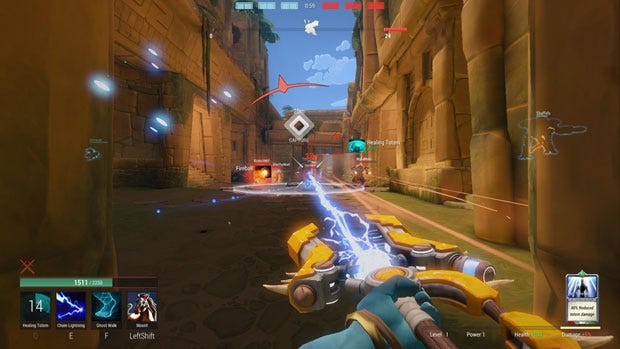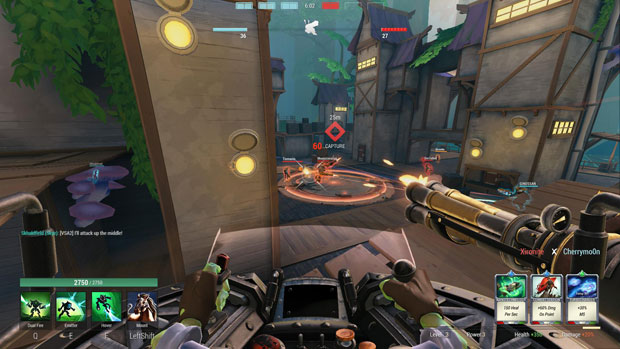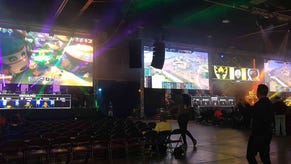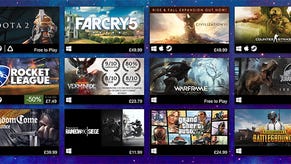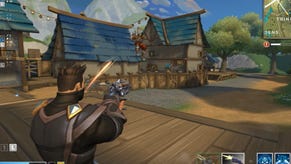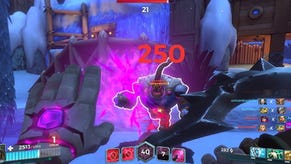Paladins: When A Shooter And A CCG Have A Baby...
Playing your cards right
"It's a card game but it's a shooter but it's a MOBA but it's kinda not and there's characters… JUST MAKE IT WORK!"
Rory "Drybear" Newbrough is laughing as he talks to me about the process of creating Paladins: Champions of the Realm [official site], Hi-Rez's shooter where in-game progression comes comes via a collectible card system. I've been trying out the closed beta and had a whole heap of questions about where the game came from and where it's going. Lead designer Newbrough (and studio president Stew Chisam) were on hand to answer:
Before we go any further I'll run down what matches look like at the moment. In the closed beta you can play against either AI or real opponents. The game mode that's open at the moment has you rushing to capture a point and then holding it until a siege cannon spawns. When it does you can accompany it to the enemy base and start knocking down gates, forcing your way into the enemy vault. There's an escort and protect element because the cannon is far better at knocking down the gates than you are solo, as well as all the shooter aspects, taking out foes as they contest the point, try to guard against your push or attack your own base.
Over the course of a game (games take about 10-15 minutes in my experience) you level up. Each level gives you a selection of cards to pick from and it's through these cards that you can earn better abilities or build your character in response to how the game is going. It feels somewhere between Heroes of the Storm's talent tree and League of Legends' new mastery system to me.
The game started development in 2014 because Hi-Rez wanted to return to the shooter idea, although it took a fair while to settle into what Paladins is now.
"We started with a very small team under 10 people, probably April or May of 2014," says Chisam. "The broad direction was we wanted to build a team-based shooter that had some of the aspects we really loved about Global Agenda PvP but did a few things differently and solved some of the problems we thought Global Agenda had had in its PvP."
Once the desire to create a multiplayer shooter had been established Hi-Rez began iterating and experimenting. "We tried Smite maps, we tried Tribes maps, we tried Global Agenda maps, we tried putting drones in there and monsters in there," says Drybear. "I think one of the turning points for us, that we knew was like 'Hey that's Paladins!' is right when we put in the mounts and the cards, probably about eight or nine months ago. We were like, 'That's actually really cool – let's do that and started iterating on it'."
From then on it was a matter of experimenting with all the different permutations of cards and characters and team sizes they could think of.
"It could be a buff system, it could be a talent system – it's just a way to change your character or empower it in different ways," says Drybear. "Once we had settled on a fantasy theme we wanted to make sure that bled through all the elements so cards made a lot of sense to us, to have that magical, whimsical aspect come through the cards."
The team also wanted to see if they could solve a problem they'd noticed in Smite as well as other MOBAs and RPGS.
"If you find a build you like you're going to build that every single time until you die," says Drybear. I think guiltily about the Cupid build I like which probably hasn't changed since Smite was in beta. "We noticed this when we put in recommended builds in games or popular items. We can put anything we want on the popular items tab in Smite and people will build that every time.
"The core idea of Paladins when we started the project was we wanted to make sure we could break that trend [and allow] you to play differently every game and every experience and match is slightly different. You don't get a repetitive experience. The card system really played into that perfectly."
He talks about card synergies – the card that will set units on fire and the one which lets you deal more damage to units which happen to be on fire have an obvious relationship. He also mentions Pip, a small squirrely character with an explosive flask, a slowing ability and a jump. Drybear likes the flask and will get cards to augment that and suggests perhaps I might like the jumping ability so I would build a deck around that. I explain that, ironically, I am probably the worst Pip player I know. I'm far more likely to be zooming about as Ruckus and Bolt (a goblin and mech suit combo pairing).
Thing is, from what I've seen of card play via Hearthstone, there's a danger that although you could try out all these cool playstyles you end up not doing so because there are clear optimal combinations.
"That's always a consideration," says Drybear. "Obviously balancing Smite is relevant and I've played games professionally before - I was a professional CS player and all that. At that level it's hard to avoid 'optimal'. There will be a path that is better than a path, even if it's by 0.05 percent it's still better. That's why when you play a casual match of Paladins you'll draw randomly from all your cards, you don't even build a deck right now."
So at the moment there's a greyed out option for constructed card play and the ones you can access are the practice mode against AI and the casual play. In casual play as Drybear says, you don't pre-set the cards you'll draw, you just get a choice of three which the game hands you when you level up and you make the best of that. It's the more useful mode initially in beta because it stops people sticking with a comfort build, forcing them to experiment. The team are also still working on the constructed mode as well as concepting a ranked play option.
Drybear points out that there's that shooter skill element deeply embedded in the game. It's theoretically possible (although difficult) to do well without the cards – he found that out thanks to a bug which didn't let him draw any cards one game. "Because of my shooter background I was able to outplay most of the players. In fact in the game I had no cards I end up going 12 [knockouts] and 3 [deaths]."
"It's not that you need the cards as a crutch, it's that they amplify you and alter your gameplay," he explains. "It's not that you HAVE to have these specific cards. Whatever way you play that fits you best, that's the way you play."
But what about situations where it feels like the cards are against you? Might a casual player get screwed over if they don't get the right card draws one match?
"When we launched the closed beta it was pure RNG. You were drawing cards in game and there was about equal chance for all cards except legendaries [which had a reduced chance to drop]."
Basically it was possible that at level one I could draw something that made me move slightly faster and my opponent could draw some epic card, or even a legendary. A little augment versus an ultimate ability. A few days after the closed beta launched that system got replaced by a more curated version.
"That system where you got random cards felt very loose to the point where it didn't seem like you were on an even playing field," admits Drybear. "So we added a system where you draw cards per level based on rarity. Everyone in the game for levels one and two will draw common cards, level three will draw a rare, level four you draw an epic and level 5 you draw a legendary. If you don't have any of those you draw downward so if you don't have a legendary [in your collection] you'll draw epics.
"It introduced that RPG style ramp up and a little bit of MOBAs as well where you start weak and get stronger and stronger. We also made sure to move a lot of the damage cards away from the common levels. Common is more that you get some utility aspects – I change some of my movement abilities, I alter the way I play but I'm not blowing anyone up. As you get more and more you get stronger. That had a huge impact."
Over the course of each game I tend to get to about level four or five but presumably games can go long, particularly with evenly matched teams. An earlier version of Paladins had nine levels of card draw. You would get to level five and pick up a legendary and then wrap around to level one again in order to replace the original card with a second legendary, carrying on until you had five legendaries. Hi-Rez are thinking of going back to that system so as to enable characters to ramp up over the course of longer games.
There are eight playable characters in Smite at the moment with three more in the pipeline. There are also two more maps in development and at least 35 cards. The studio is expecting a slower growth of the Paladins cast than it has with Smite. "Smite adds one at least every month," says Drybear. "It will probably be maybe half as fast as that. But our plan is to continually add characters for the lifetime of the game, and cards as well.
"My goal right now as lead design is I want to make sure we get to at least thirteen to fifteen characters as fast as possible because for a character-based shooter the way it maps out is you want to have at least fourteen or fifteen characters. What that does is, from a probability standpoint, is make sure you don't see the same characters every game. You have a lot of options to choose from and it feels like there's a more rich experience."
A diverse character roster can also be used to attract a more diverse player base or to target particular demographics.
"With eight characters you might see a play style there that's yours and you're really excited about it but maybe you really like snipers a lot and we don't have a sniper currently so you'll be a little turned off by that. So we may or may not be planning a sniper coming soon," he says. "MAY OR MAY NOT."
It's not strictly Paladins but I'm curious to know how character types map to demographics.
"There are a lot of very easy ones," says Drybear. "Sniper is a great one. Usually younger boys between 12 and 16 really love sniper. They also love the darker characters, the Batmans and the crazy creepy angels of death – Thanatos is a good example on Smite. We know that hits a specific audience. The assault run-and-gun machine gun, usually boys between 17 and 24 will have that Call of Duty experience with that. So there are some very easy archetypes that you can fit into that are obviously akin to other titles or experience they have in other games.
"Obviously it's loose because Paladins may hit a different audience than we expect but just in generalisations when we look at the market and understand statistics we can point at certain areas and say 'People really want this kind of playstyle. Can we craft an experience that matches it in some way?"
Apparently when you get to my age (i.e. over 24) there's more variety. It's the younger players who are more particular. That said rocket launchers and grenade launchers are things I might gravitate towards.
Okay, so a look at the champions. First thing to note is that they are champions and not Paladins. Drybear explains that that's part of the game's lore which is still being fleshed out at the moment. The general idea is that "there were Paladins at some point and they go away but why did they go away? What is the intrigue there?" There are also bits of futuristic technology in this fantasy-style world so the idea is that the lore will bring in more detail on that front.
In terms of play, Cassie and Pip are the big crowd-pleasers. Pip I've mentioned before and Cassie is an archer character who reminds me a lot of Dota's Windranger with her ginger hair, green costume and bow and arrow.
Cassie is one of only two female characters in the lineup at the moment and both she and Skye are of a type when it comes to bodies. Apparently the ninth character, and likely the tenth, will be female, though, so I'm curious to see how they turn out and whether they add a bit more variety. As we talk Drybear adds that variety in character design is something he's keen on building into the game.
"With Smite I did a lot of ratio analysis of male to female to creature. One of the reasons we did Chiron, Ratatoskr, Khepri – Khepri and Ratatoskr are my designs – was, 'Guys we have to have creatures, we have to have more females. We can't have a whole bunch of males.' So I'm huge on that, making sure the ratios are there. You can break those boundaries instead of making a whole bunch of tall white masculine males as all your characters. You can get some variety in there."
When I spoke to the Overwatch developers earlier this year one of the character discussion topics was about melee characters in a shooter-type game and how hard it had been to get further than one. Paladins' team experimented with the idea a lot early on but it never got to the point where they were satisfied with the result. A lot was to do with being in first-person but that's an issue the team might be relatively well-placed to change.
"We have a unique boon in our favour in that we do both third person and first person camera," says Drybear. When you're mounted you go out into third person, same thing when you're jumping as Pip or flying as Ruckus. "That solves the issue so when we're ready and we feel like we want to do a good melee character we can do that in third person. It makes perfect sense. It happens in Smite, half the characters in Smite are third person melee. [...] As far as first person, it's hard to say whether we would ever do a character where their main weapon in first person is melee. We certainly *could*. We might get some interesting systems around that. But it's more likely there will be characters that have a lot of fun abilities that do melee."
On page two, connections to Smite, Paladins' business model, mode design and the psychology of scoring.
The other character question I had was about Smite. Will Smite characters start popping up in Paladins at all? The answer is that Hi-Rez are trying to separate their IPs so if they do have any Smite references it won't be in the manner of Heroes of the Storm or other all-star games, it'll be more like nods to a shared creator. An Ares skin for the Fernando character, for example.
"We might stick Ratatoskr in one of the maps and do little things like that – we're all big fans of both titles – but we want to make sure Paladins stands on its own as an individual IP and has its own character base."
Talk turns to gameplay again. I know the team has two maps in development but we haven't spoken about different game modes yet. It's here where Drybear thinks the team can address a problem that they noticed with Smite.
The problem is that Smite's various game modes are pretty different experiences and involve different maps, monsters, timings, objectives and metas. If you're used to playing Arena (which is where you try to escort minions to a portal on the other side of this round, open play space) then Conquest (the 5v5 lane-pusher you'd recognise as akin to Dota or League of Legends) is utterly baffling. It can be hard to keep a sense of a coherent or unified player base.
"What we're trying to accomplish with this game it to try and make it so the base experience, much like many shooters, is the same," says Drybear. "When you play Halo for example and you play extraction or another game mode, it still feels like Halo because you're playing the same characters with the same weapons. It's more about learning the map."
There are three modes that are on the table at the moment. One is about capturing and holding points, one is ticket-based (e.g. you start with a certain number of tickets and the objectives you take against your enemy cost them tickets). The last is about collecting an army of zombies within a time limit then pitting them against one another when the time runs out.
"The goal is to try and fit as many as possible on the same maps so they use the same core capture point and base system but they mix it up in interesting ways," he says. "That way if you play Paladins and I play Paladins we have similar experiences and we can share those."
In terms of the cards, they're all linked to characters although some do the same thing. Pip's Lob and Cassie's Heavy Cord both have the effect of letting weapon shots travel 50% further. They have also birthed enormous spreadsheets in the Hi-Rez offices.
"We're saying every character has to have a minimum of 30 cards or as close as possible. If you only have 10 cards it feels very flat because there's not many options. You may not get the cards you want – that sort of thing. We want to make sure the floor [the game's barrier to entry as opposed to its skill ceiling] is the first thing we're concerned about and every character has a plethora of options. As we grow we'll see. There's going to come a fork when we decide do we want a lot of cards on a few characters or a lot of characters with few cards. That's going to be a pretty easy divide as maybe we have 45 characters and each character has 45 cards, or 20 characters and each character has 90 cards. That's going to be an interesting divide. When we hit that row we'll figure it out."
In terms of how the game will develop in other ways, Drybear doesn't want to go down the expansions route, nor is he keen on adding cards to the point where some become invalidated or obsolete. That doesn't mean not introducing new systems over time nor are cards immune from being reworked. It's more about not pursuing a development plan where a lot of content is locked away.
On the business model front he says, "For us the champions will be free into the future so you won't have to worry about getting characters. For the cards themselves we are still deciding a monetisation plan. We don't have that model yet. We're focusing more on making those cards part of a collection process. We're trying to make that as accessible as possible."
The idea is that you'll earn cards through wins, chests by leveling up and earn gold by playing. Currently in beta it seems that you get a chest when you level up your account (the radiant one drops five cards) and you get a card when you win. Obviously that stuff's all being tinkered with and it makes sense to be super generous in beta so people are actually trying the cards and seeing if anything breaks so that might all change.
Speaking with Stew Chisam he adds:
"The game will definitely be free to play. We'll probably evolve the exact mechanics of all the different pieces of monetisation over time. Obviously with cards there's some opportunity for card packs to make some real money although we believe very strongly that anything that affects gameplay should be able to buy for a reasonable price in in-game currency – you don't have to pay for it.
"80-something percent of our revenues on Smite come from cosmetics and it's taught us a valuable lesson. At this stage to be honest we worry very little about monetisation because this is now our fourth free-to-play game. (Global Agenda didn't start as a free to play game but it ended there.) Through that process I think we've learned the most important thing by miles and miles is to get a game people want to play."
Ranked is proving an interesting challenge at the moment though. "Because we've blended these genres we get all the benefits of the genres and all the downsides," is how Drybear puts it.
One of my thoughts is that if Hi-Rez succeeds in making the game super-varied and with all these myriad potential playstyles that might mean a heck of a lot of learning and anticipating if you're trying to counter champions and builds.
"I've been losing sleep over the last few months trying to figure out how to make that ranked mode work in a way that isn't obstructive in some way. You have the RNG aspects, you have the meta aspects – generally it's a little bit easier for ranked because the people who gravitate towards ranked are your hardcore players that will stay up all night creating a spreadsheet of what's the most efficient thing to build and all that."
One of the ideas being batted around at the moment is that you could set the card drops for each level, laying a character's card deck out like a skill tree and picking the options that best fit the game you're having. Another option is to have a couple of ban/pick phases, one for champions and another for cards. Again, it's very much a game in flux on that front at the moment.
The last thing I wanted to mention is the scoring and feedback system particularly when it comes to rewarding things that aren't shooting in a shooter.
"If you look back at Global Agenda we actually did a lot of this. There was a system – don't tell anybody! – in there where at the end of a match there was a big long scoreboard of different stats and it would justify to the one you were best at. So if you were the best healer or the best tank or the best damage or you captured the most points that would be the first thing you see and it would be highlighted like 'You are the man! You are the girl! You did it – you're awesome!'
"You can also look at psychology, Skinner boxes, reward loops and making people feel good, how that works in the brain. It's very fascinating. But really a lot of it is making sure whatever aspect you're trying to accomplish you feel you're doing it well."
To that end, scoring is going to be tailored to each character. For example, Fernando is a character with a relatively short range flamethrower for his basic attack, he's pretty tanky and has a shield as one of his abilities so you generally want him down on the capture point while you summing the siege cannon. He'll likely get a lot of points for tanking damage and for being on the capture point. Grohk is an orc shaman with a chain lightning attack so he might get lots of points for zapping multiple enemies with that.
At the moment it's not like that though. The majority of your score is just match performance stuff like kills and damage dealing and healing.
One thing which is in place at the moment is the game not explicitly differentiating between you getting the killing blow and you getting an assist. It'll make a slight difference to your score but in terms of the verbal feedback the game gives they've been consolidated. It's to do with limiting toxicity.
"You start looking at it like, 'We're doing good!' rather than 'I'm not doing as good as I could be'."
Player responses and behaviour are also influencing other aspects of the game. "It's one of the reasons why the minimap isn't perfectly on the screen, you have to tab for it. When you see the a minimap and you're on the point and you look at your teammates across the map you're mad about it. 'You're off the point, what are you doing?' If you don't actively see that you focus more on what can I do on the point."
I'm wondering whether that will change once ranked gets added in. Perhaps the ability to track teammates and co-ordinate will be more valuable than the behavioural aspect when it comes to ranked or team-based play. As I say, it's still very much a work in progress.
There's no full-release date scheduled but constructed decks are expected to arrive either by the end of 2015 or at the start of 2016. I've had fun with the casual mode but I think how constructed plays out will govern how much of a timesink Paladins turns out to be for me.
